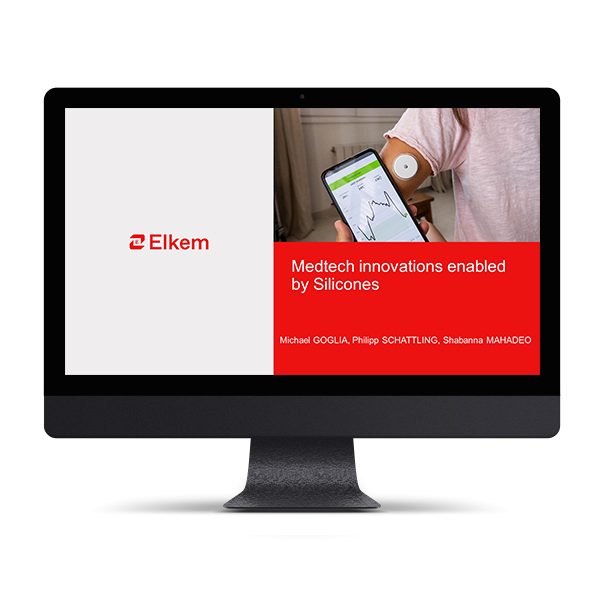- Magazine
- Healthcare
- Wearable devices in healthcare: new possibilities for silicone materials
Wearable devices in healthcare: new possibilities for silicone materials
The wearables sector is growing fast. According to GlobalData forecasts, the market will have grown at a CAGR of 19% between 2019 and 2024. Consumer electronics have always dominated the wearables market, although their focus on health and wellness monitoring is blurring the lines with healthcare.
Such devices are helping patients bring healthcare into their own hands, believes Philipp Schattling, project leader diagnostics and long-term medical implants at Elkem Silicones. “Wearable devices help us to understand our vital data better and use them to interpret and understand our ‘feelings’ or health conditions,” he explains.
Smartwatches commonly track heart rate, skin temperature, oxygen saturation, physical activity, sleep, and stress levels. In 2018, the Apple Watch Series 4 was the first smartwatch to offer ECG readings and atrial fibrillation or irregular heart-rate rhythms checks. This development marked a key turning point for the smartwatch, which became not only an interesting source of general wellness information but a potentially life-saving tool for elderly people or cardiology patients.
By 2030, 14% of the global population are expected to use smartwatches. While these devices make up the largest portion of the wearables market, there are many notable innovations in the smart clothing space too, where smart fabrics with interwoven circuitry are utilised for added functionality.
Most smart clothing products target the fitness industry, such as a T-shirt that records physical activity and sweat levels, and a pair of socks that detect which part of the foot receives the most pressure during a run.
Medical wearables
After consumer electronics, the second biggest market for wearable devices is healthcare. The impact of the COVID-19 pandemic on the telemedicine and remote patient monitoring landscape has accelerated the growth of this market. In these applications, wearable sensors (usually in the form of smart patches or wrist watches) send a patient’s health data directly to clinicians, enabling the clinician to monitor chronic illnesses without the need for patient visits.
This allows for the constant collection of data, giving the clinician a better picture of the patient’s overall health and specific disease on a day-to-day basis, as opposed to occasional visits. Similar devices have proved highly valuable in clinical trials, particularly in decentralised trials where patients are monitored from their own homes.
Some medical wearables go one step deeper, penetrating the surface of the skin through microscopic needles or fully implanted devices to continuously monitor the physiological status of the body. Continuous glucose monitoring systems use sensors in this way, combining the technology with a wearable drug infusion device and a smart phone app to close the loop.
For patients with type two diabetes, this is a revolutionary system that alleviates the burden of constant blood tests and manual insulin shots throughout the day. “This is where we’re seeing this wearable trend heading on the medical device side – the monitoring, diagnosis, and treatment of health conditions by delivering drugs in innovative ways,” says Bob Waitt, global market manager, healthcare at Elkem Silicones.
As such devices might be implanted long-term, silicone technologies have become a key material in their fabrication. “For implantable wearables, it’s obviously very important that the material requirements comply with specific regulations, suitable for long-term implantation. Elkem supports these requirements with our Silbione™ Biomedical range of medical-grade silicone materials,” says Schattling.
The Silbione™ and Silbione™ Biomedical grade materials include liquid silicone rubber (LSR) and high consistency rubber (HCR) solutions, as well as silicone adhesives and sealants for high-strength bonding. This way, silicone solutions can be utilised to produce a wide range of components in wearable devices.
For adhesive patches, Silbione™ skin adhesives can be used to attach the device to the skin. Varying tack levels are available, all offering gentle, non-irritating yet secure skin adhesion. “We offer our clients a full range of silicone materials required to build a wearable device,” says Schattling.
There are many advantages to choosing silicone – a biocompatible, durable material compatible with a range of sterilisation methods. In addition, LSR is suitable for injection moulding, enabling manufacturers to quickly scale-up production and meet the demands of this fast-growing market. Silicone also offers solutions for waterproofing, anti-slip textile coating, and protecting sensitive electronics – all important requirements in the world of wearables.
As the medical device industry maintains and increases its focus on wearable technology, many more developments are expected in this space. As one of the world’s leading suppliers of silicone technologies, with a broad range of materials that facilitate the development of smart clothing, patches, watches, and more, Elkem Silicones is ready to work with its customers on the next wave of wearable medtech.

